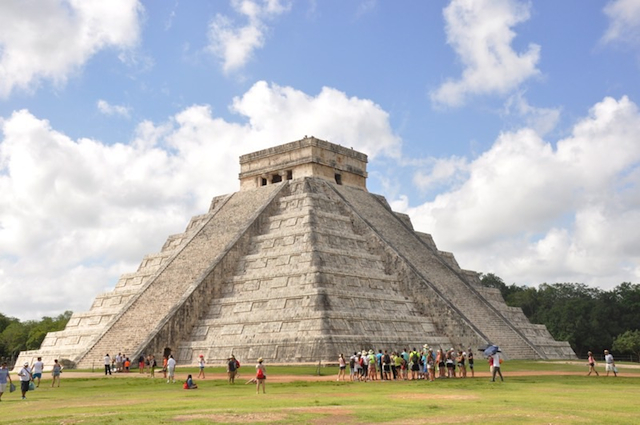
Climate sceptics can follow the Myans
By Crispin Hull
Published Monday 3 August 2015

The next conference of the Climate Change Sceptics Association should be held on the Yucatan Peninsula, in Mexico, where my wife and I have been this the past week.
About 65 million years ago, just north of Yucatan, a huge asteroid struck the earth, sending billions of tonnes of dust into the atmosphere. As a result a lot of the sun’s radiation bounced off before it could hit the earth. The earth cooled suddenly. Plants species collapsed. The dinosaurs were wiped out – all the space of a few years, as the fossil and geologic record shows.
Lesson: climate change can wipe out dominant species.
After this session, the conference delegates would get into their cars (not air-conditioned buses) to go to the famous Maya ruins of Chichen Itza.
The temperature this year in Yucatan – like many places on earth -- has been unusually hot – nudging 40 degrees on many days. At next year’s Climate Sceptics Conference it will probably be as hot or hotter, and will very likely be among the 10 hottest years in the past century, as it has been in many places, but it is only one or two years, so we can retain our scepticism in the face of a tide of “hottest” records and very few “coldest”.
The cars would have been waiting in the sun and their inside temperature would be about 70 degrees – much hotter than the surrounding air.
The guides might explain this. The sun’s rays pass through the glass and get absorbed and turn to heat which is trapped in the car.
Similarly, but not identically, the sun’s rays travel through the atmosphere and hit earth. Seventy per cent is absorbed and the rest radiated back into space. This is because the totality of the light radiated from the sun travels through nitrogen, oxygen and argon which make up 78%, 21% and 0.9% of the atmosphere respectively.
About a third of the remaining one tenth of one percent is carbon dioxide through which the totality of the energy radiated back from the earth’s surface do not travel. The infrared spectrum bounces back to earth.
This was discovered in the 19th century, but its full implication was not known then.
Critically, that trapped infrared warms the earth. We would ask our sceptics what would happen if we did not have any carbon dixoxide in the atmosphere?
The answer is that the earth’s temperature would average zero degrees instead of the present livable average of 15 degrees.

Lesson: carbon dioxide is crucial to stopping the world’s temperature from plummeting. Conversely, adding extra carbon dioxide will cause the temperature to rise.
For Session Three, our delegates would be presented with information from the Mauna Loa Observatory in Hawaii. It has been measuring the level of carbon dioxide in the atmosphere since 1955 when it was 315 parts per million. In the past year it hit the 400 parts per million mark. Measurements of the atmosphere from air trapped in ice tell us that before the Industrial Revolution carbon dioxide was just 280 parts per million.
For Session Four we visit the ruins at Chichen Itza -- a vast monument to both human ingenuity and human stupidity.
By 650AD, the Mayans had created about 60 cities each with more than 50,000 people throughout the Yucatan. They worked out a solar calendar and calculated the movement of the visible planets. They had a solid system of mathematics. They built magnificent temples and civic buildings. Agriculture improved and the population boomed.
Alas, the demands of religion required the building and over-building of ever more grand temples (and, incidentally, human sacrifice). The mass of the population went along with it under the delusion that the offerings were essential to continued good rain and sunshine for their crops.
Of course, precisely the opposite was true. The more the Mayans cut down the forest for fires for the energy to create the cement and cut the stone for the temples, the more the water cycle was interrupted, according to a 2012 article in the journal science “Science”. Droughts followed.
Stalactites in a cave in Belize reveal rainfall levels in any given year through reading the limestone build up – a bit like tree rings. In the latter half of the 10 th century, rainfall contracted by around 10 percent locally – catastrophic for agriculture .
Around 1100, the Mayan farmers had had enough. They left the cities and the ruling classes and headed for the coast for a simpler life which included fishing. The Mayans and their language survive today, but their civilisation collapsed.
It is awe-generating to see the grandeur and sophistication of the doomed cities.
Lesson: civilisation cannot survive significant climate change, and very clever, sophisticated, knowledgeable people can ignore what is happening around them to their own detriment.
Other lessons: scientists find ways of measuring things. Carbon dioxide is increasing in the atmosphere. The climate has already begun to change.
During the last session of next year’s conference, our climate sceptics can follow the Mayans down to the coast where despite all obvious evidence they can dig little holes and put their heads in the sand.